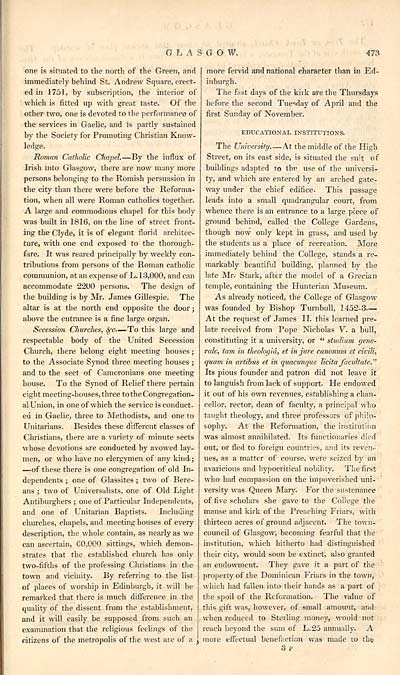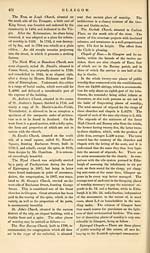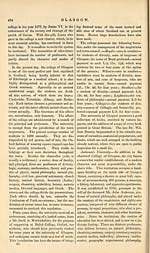Gazetteer of Scotland > Volume 1
(509) Page 473
Download files
Complete book:
Individual page:
Thumbnail gallery: Grid view | List view

G LASGO W.
473
one is situated to the north of the Green, and
immediately behind St. Andrew Square, erect-
ed in 1751, by subscription, the interior of
which is fitted up with great taste. Of the
other two, one is devoted to the performance of
the services in Gaelic, and is partly sustained
by the Society for Promoting Christian Know-
ledge.
Roman Catholic Chapel. — By the influx of
Irish into Glasgow, there are now many more
persons belonging to the Romish persuasion in
the city than there were before the Reforma-
tion, when all were Roman catholics together.
A large and commodious chapel for this body
was built in 1816, on the line of street front-
ing the Clyde, it is of elegant florid architec-
ture, with one end exposed to the thorough-
fare. It was reared principally by weekly con-
tributions from persons of the Roman catholic
communion, at an expense of L. 13,000, and can
accommodate 2200 persons. The design of
the building is by Mr. James Gillespie. The
altar is at the north end opposite the door ;
above the entrance is a fine large organ.
Secession Churches, fyc — To this large and
respectable body of the United Secession
Church, there belong eight meeting houses ;
to the Associate Synod three meeting houses ;
and to the sect of Cameronians one meeting
house. To the Synod of Relief there pertain
eight meeting-houses, three to the Congregation-
al Union, in one of which the service is conduct-
ed in Gaelic, three to Methodists, and one to
Unitarians. Besides these different classes of
Christians, there are a variety of minute sects
whose devotions are conducted by avowed lay-
men, or who have no clergymen of any kind ;
— of these there is one congregation of old In-
dependents ; one of Glassites ; two of Bere-
ans ; two of Universalists, one of Old Light
Antiburghers ; one of Particular Independents,
and one of Unitarian Baptists. Including
churches, chapels, and meeting houses of every
description, the whole contain, as nearly as we
can ascertain, 60,000 sittings, which demon-
strates that the established church has only
two-fifths of the professing Christians in the
town and vicinity. By referring to the list
of places of worship in Edinburgh, it will be
remarked that there is much difference in the
quality of the dissent from the establishment,
and it will easily be supposed from such an
examination that the religious feelings of the
citizens of the metropolis of the west are of a ,
more fervid and national character than in Ed-
inburgh.
The fast days of the kirk are the Thursdays
before the second Tuesday of April and the
first Sunday of November.
EDUCATIONAL INSTITUTIONS.
The University — At the middle of the High
Street, on its east side, is situated the suit of
buildings adapted to the use of the universi-
ty, and which are entered by an arched gate-
way under the chief edifice. This passage
leads into a small quadrangular court, from
whence there is an entrance to a large piece of
ground behind, called the College Gardens,
though now only kept in grass, and used by
the students as a place of recreation. More
immediately behind the College, stands a re-
markably beautiful building, planned by the
late Mr. Stark, after the model of a Grecian
temple, containing the Hunterian Museum.
As already noticed, the College of Glasgow-
was founded by Bishop Turnbull, 1452-3 —
At the request of James II. this learned pre-
late received from Pope Nicholas V. a bull,
constituting it a university, or " studium gene-
rale, tarn in theologid, et in jure canonum et civili,
quam in artibus et in quacunque licita Jacultate."
Its pious founder and patron did not leave it
to languish from lack of support. He endowed
it out of his own revenues, establishing a chan-
cellor, rector, dean of faculty, a principal who
taught theology, and three professors of philo-
sophy. At the Reformation, the institution
was almost annihilated. Its functionaries died
out, or fled to foreign countries, and its reven-
ues, as a matter of course, were seized by an
avaricious and hypocritical nobility. The first
who had compassion on the impoverished uni-
versity was Queen Mary. For the sustenance
of five scholars she gave to the College the
manse and kirk of the Preaching Friars, with
thirteen acres of ground adjacent. The town-
council of Glasgow, becoming fearful that the
institution, which hitherto had distinguished
their city, would soon be extinct, also granted
an endowment. They gave it a part of the
property of the Dominican Friars in the town,
which had fallen into their hands as a part of
the spoil of the Reformation. The value of
this gift was, however, of small amount, and
when reduced to Sterling money, would not
reach beyond the sum of L.25 annually. A
more effectual benefaction was made to the
3 p
473
one is situated to the north of the Green, and
immediately behind St. Andrew Square, erect-
ed in 1751, by subscription, the interior of
which is fitted up with great taste. Of the
other two, one is devoted to the performance of
the services in Gaelic, and is partly sustained
by the Society for Promoting Christian Know-
ledge.
Roman Catholic Chapel. — By the influx of
Irish into Glasgow, there are now many more
persons belonging to the Romish persuasion in
the city than there were before the Reforma-
tion, when all were Roman catholics together.
A large and commodious chapel for this body
was built in 1816, on the line of street front-
ing the Clyde, it is of elegant florid architec-
ture, with one end exposed to the thorough-
fare. It was reared principally by weekly con-
tributions from persons of the Roman catholic
communion, at an expense of L. 13,000, and can
accommodate 2200 persons. The design of
the building is by Mr. James Gillespie. The
altar is at the north end opposite the door ;
above the entrance is a fine large organ.
Secession Churches, fyc — To this large and
respectable body of the United Secession
Church, there belong eight meeting houses ;
to the Associate Synod three meeting houses ;
and to the sect of Cameronians one meeting
house. To the Synod of Relief there pertain
eight meeting-houses, three to the Congregation-
al Union, in one of which the service is conduct-
ed in Gaelic, three to Methodists, and one to
Unitarians. Besides these different classes of
Christians, there are a variety of minute sects
whose devotions are conducted by avowed lay-
men, or who have no clergymen of any kind ;
— of these there is one congregation of old In-
dependents ; one of Glassites ; two of Bere-
ans ; two of Universalists, one of Old Light
Antiburghers ; one of Particular Independents,
and one of Unitarian Baptists. Including
churches, chapels, and meeting houses of every
description, the whole contain, as nearly as we
can ascertain, 60,000 sittings, which demon-
strates that the established church has only
two-fifths of the professing Christians in the
town and vicinity. By referring to the list
of places of worship in Edinburgh, it will be
remarked that there is much difference in the
quality of the dissent from the establishment,
and it will easily be supposed from such an
examination that the religious feelings of the
citizens of the metropolis of the west are of a ,
more fervid and national character than in Ed-
inburgh.
The fast days of the kirk are the Thursdays
before the second Tuesday of April and the
first Sunday of November.
EDUCATIONAL INSTITUTIONS.
The University — At the middle of the High
Street, on its east side, is situated the suit of
buildings adapted to the use of the universi-
ty, and which are entered by an arched gate-
way under the chief edifice. This passage
leads into a small quadrangular court, from
whence there is an entrance to a large piece of
ground behind, called the College Gardens,
though now only kept in grass, and used by
the students as a place of recreation. More
immediately behind the College, stands a re-
markably beautiful building, planned by the
late Mr. Stark, after the model of a Grecian
temple, containing the Hunterian Museum.
As already noticed, the College of Glasgow-
was founded by Bishop Turnbull, 1452-3 —
At the request of James II. this learned pre-
late received from Pope Nicholas V. a bull,
constituting it a university, or " studium gene-
rale, tarn in theologid, et in jure canonum et civili,
quam in artibus et in quacunque licita Jacultate."
Its pious founder and patron did not leave it
to languish from lack of support. He endowed
it out of his own revenues, establishing a chan-
cellor, rector, dean of faculty, a principal who
taught theology, and three professors of philo-
sophy. At the Reformation, the institution
was almost annihilated. Its functionaries died
out, or fled to foreign countries, and its reven-
ues, as a matter of course, were seized by an
avaricious and hypocritical nobility. The first
who had compassion on the impoverished uni-
versity was Queen Mary. For the sustenance
of five scholars she gave to the College the
manse and kirk of the Preaching Friars, with
thirteen acres of ground adjacent. The town-
council of Glasgow, becoming fearful that the
institution, which hitherto had distinguished
their city, would soon be extinct, also granted
an endowment. They gave it a part of the
property of the Dominican Friars in the town,
which had fallen into their hands as a part of
the spoil of the Reformation. The value of
this gift was, however, of small amount, and
when reduced to Sterling money, would not
reach beyond the sum of L.25 annually. A
more effectual benefaction was made to the
3 p
Set display mode to: Large image | Transcription
Images and transcriptions on this page, including medium image downloads, may be used under the Creative Commons Attribution 4.0 International Licence unless otherwise stated. ![]()
| Gazetteers of Scotland, 1803-1901 > Gazetteer of Scotland > Volume 1 > (509) Page 473 |
|---|
| Permanent URL | https://digital.nls.uk/97430470 |
|---|
| Description | Volume I: Abbey to Glenartney. |
|---|---|
| Attribution and copyright: |
|
| Description | By Robert Chambers and William Chambers. Glasgow: Blackie & Son, 1838. 2 volumes. |
|---|---|
| Shelfmark | NF.1461.g.7 |
| Additional NLS resources: | |

